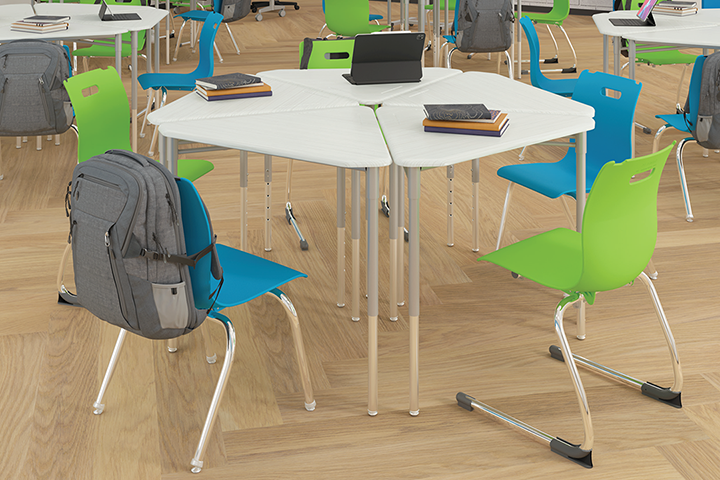A Guide to Ergonomics in Education Settings

Considering ergonomics in education settings is vital when it comes to designing comfortable, supportive learning spaces. From K-12 to higher education, ergonomic design can contribute to students’ physical well-being, focus and academic outcomes.
Our guide covers everything you need to know about creating effective ergonomic learning environments. We’ll discuss the key elements of ergonomics in the classroom, age-related considerations and future trends for ergonomics in education.
Understanding Ergonomics in Education
Ergonomics, or human engineering, focuses on designing products and environments to optimize human performance and behavior. Specifically, “ergonomic furniture” refers to items designed to improve comfort, efficiency and safety for users.
Ergonomic design plays a crucial role in educational settings. It enhances student comfort, improves concentration and reduces physical strain, leading to better learning outcomes and overall well-being.
While many associate ergonomic furniture with improving posture, its benefits go beyond this. For instance, Ruckus chairs allow users to sit in multiple positions, enhancing comfort and focus. This versatility promotes student engagement and facilitates hands-on learning in classrooms.
Proper Posture and AlignmentGood posture and alignment are crucial for student health and academic performance. Maintaining proper posture reduces the risk of musculoskeletal problems like back, shoulder and neck pain. Good posture also promotes better breathing and circulation, enhancing concentration and cognitive function.
Ergonomically designed furniture supports natural body positions, enabling students to sustain comfortable, effective posture throughout the day.
For instance, KI’s Stout tables come in a variety of depths, widths and fixed heights to suit different working postures, ideal for STEAM (Science, Technology, Engineering, the Arts and Mathematics) settings. Optional features include footrests, bag hooks and power outlets.
Adjustable Furniture and EquipmentModern classroom environments benefit from adjustable furniture and equipment as they accommodate collaborative, dynamic teaching styles. Flexible school furniture, such as adjustable student desks and mobile chairs, allows educators to easily adapt classroom layouts for diverse activities and lessons.
For example, MooreCo’s Hierarchy Creator tables are fantastic for creating adaptable learning spaces. Available in six dynamic shapes, including triangle, trapezoid and chevron, these tables facilitate seamless transitions between interactive and focused work.
This adaptability also promotes student collaboration, fostering a sense of community and shared responsibility for learning. Research shows that students in classrooms with flexible furniture have more positive feelings toward their learning environment and schooling than those in traditional settings.
Appropriate Lighting and AcousticsLighting significantly impacts the effectiveness of learning spaces. A review of 130 studies found that dynamic, well-balanced lighting can enhance attention, productivity and accuracy. Meanwhile, poor lighting can hinder visibility and reduce engagement, especially for students with developmental disabilities.
A 2021 study proposes optimizing natural sunlight in classrooms, as this can boost performance and child development. However, too much direct sunlight can impair test scores, so shades or window decorations are necessary for preventing glare.
Effective acoustics are also important for learning. Clear hearing and focus during teacher-led lessons and community-based learning are essential for students. Overly loud background noise can adversely impact speech perception and short-term memory, which are both integral to reading acquisition
Optimal Classroom Layout and SpacingCreating an optimal classroom layout involves thoughtful planning of seating arrangements and learning zones. For instance, small clusters of desks are often best for collaboration, whereas seating in rows and columns tend to suit independent work.
Additionally, spaces that encourage regular movement breaks benefit student engagement and behavior. Furnishing classrooms with options for sitting, standing and reclining can help foster more movement.
For example, MooreCo’s Respite all foam soft seating in the shape Lean supports a relaxing posture that allows students to read or work in a semi-upright position. This supportive seating promotes autonomy and choice, providing comfort for students as they learn.
Inclusive Classroom Design for Ergonomics in EducationInclusive design is vital in creating ergonomic educational spaces that cater to diverse learners. Research shows that modern classroom designs that consider aesthetics empower students of different backgrounds to engage meaningfully.
As of 2023, there were 7.5 million students with a disability in the U.S., highlighting the need for inclusive educational environments. Students with physical, social, emotional or cognitive disabilities may struggle to navigate traditional classroom settings.
Instead, inclusive design elements such as accessible seating, adjustable tables and integrated technology can create equitable learning spaces where students with different abilities can thrive.
Ergonomics In Education for Different AgesNow that we’ve looked at universal ergonomic design principles, it’s time to consider the age of the students you’re designing for. Students at different educational levels need different ergonomic solutions to support their physical needs and learning styles.
For instance, height plays a significant role in determining furniture size, with older students needing taller seating and tables than younger children. Adjustable seating can accommodate children’s growth spurts, which are typical during middle and high school.
Meanwhile, early childhood and elementary school classrooms benefit from age-appropriate furniture that caters to varying sizes among children who grow rapidly during this period.
As children progress through their education, teaching styles and learning approaches evolve to meet their changing needs. Ergonomic classroom design should reflect these changing needs.
For example, young learners thrive in engaging spaces that foster play, discovery and gross motor development. Multi-purpose, mobile stations can facilitate switching between structured and unstructured learning activities.
In contrast, older students need dynamic environments supporting independent study and collaborative work. They also tend to sit for longer periods than young learners, so ergonomic chairs with lumbar support are essential for comfort and concentration.
Modern higher education environments are increasingly embracing adaptable, technology-rich designs over traditional classrooms. These spaces need ergonomic furniture and design solutions that accommodate versatile teaching methods and promote immersive learning experiences.
Ergonomics In Education: Furniture and Equipment
ChairsErgonomically designed chairs are essential for creating optimal educational environments for students and teachers alike. Fixed or uncomfortable seating can lead to distractions, discomfort and health issues, ultimately hindering effective learning outcomes.
Investing in adjustable seating that accommodates various postures and body sizes improves comfort and fosters a conducive learning environment.
For instance, Smith System’s Flavors chair line offers maximum movement with four seating positions. The chairs’ flexible seat back allows students to shift and move comfortably without resistance. These chairs provide the benefits of a stability ball but with more overall solidity and back support, and students are less likely to misuse them.
Mobile chairs are ideal for classrooms as they facilitate quick rearrangements to align with different learning activities. For example, the Savvy chair from Alumni features various bases, including casters for easy movement. This innovative design also has built-in backpack hooks and comes in various sizes, making it suitable for diverse learning environments.
In spaces outside the classroom, such as media centers and student lounges, comfortable, dynamic chairs, like KI’s Sway lounge seating, are ideal for studying and socializing. Sway lounge chairs allow for fluid orbital motion thanks to their seamless 360-degree swivel.
DesksErgonomic desks play an important role in creating a comfortable, productive learning environment. Adjustable-height desks accommodate students of all ages and sizes, promoting proper posture and reducing strain. Additionally, they can convert into standing desks, which promote movement and mitigate the health risks linked to prolonged sitting.
For instance, the MooreCo Grow and Roll Desk adjusts effortlessly to cater to varying student needs. The desk’s ergonomic design and casters promote movement in the classroom and allow students the option to sit or stand.
Storage SolutionsEffective storage solutions like lockers and cubbies are indispensable in ergonomic classroom settings. They contribute to a well-organized space, minimize clutter and ensure easy access to materials. The resulting tidy environment enhances student focus, safety and overall learning experiences.
Ruckus worktables are a fantastic example of ergonomic furniture that provides storage and supports various learning space layouts. Features such as cubby or tote storage with optional locking doors, bag hooks, removable shelves and power modules enhance functionality and organization. Laptops, Tablets and Other Electronic DevicesIntegrating technology into classrooms requires furniture that supports modern learning environments. Features like built-in power outlets and cable management solutions can promote the ergonomic use of laptops, tablets and other devices.
For example, Haworth’s Intuity benching is ideal for computer labs. This sleek benching includes split or full-access power and data hatches to promote an efficient, clutter-free workspace.
While screens can enhance learning, research shows that prolonged use may lead to decreased executive functioning and academic performance. Excessive screen usage can also result in eye strain and pain related to poor posture.
Ergonomic furniture encourages students to move more often, thus taking regular screen breaks, promoting better focus and reducing discomfort during digital learning activities.Future Trends for Ergonomics in Education
Looking ahead, future trends for ergonomics in education include:
● Enhanced integration of technology solutions, such as furniture featuring optional tablet arms (like MiEN’s Chameleon Lounge Square Chair, also available with an optional power or USB charging unit).
● Emphasis on eco-friendly furniture and sustainable materials, including recycled plastics and responsibly sourced wood.
● Increasingly flexible layouts that adapt to various educational settings, including content-flexible and content-specific spaces.
● Adoption of inclusive design principles to create accessible learning environments for diverse learners.
WB Wood is at the forefront of educational environment design solutions. We partner with more than 300 manufacturers and distributors to help customers procure top-tier, ergonomic furniture. Contact us to start the conversation about how we can assist with your ergonomic classroom designs.
